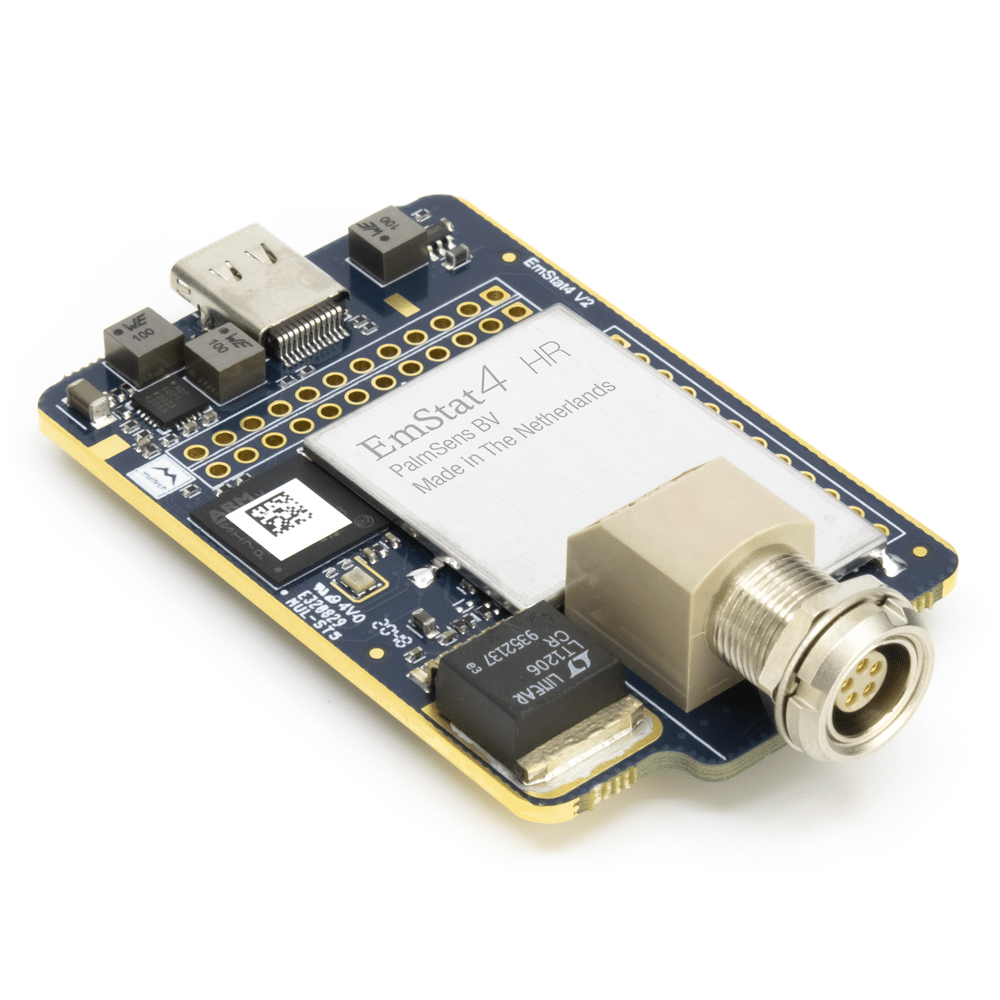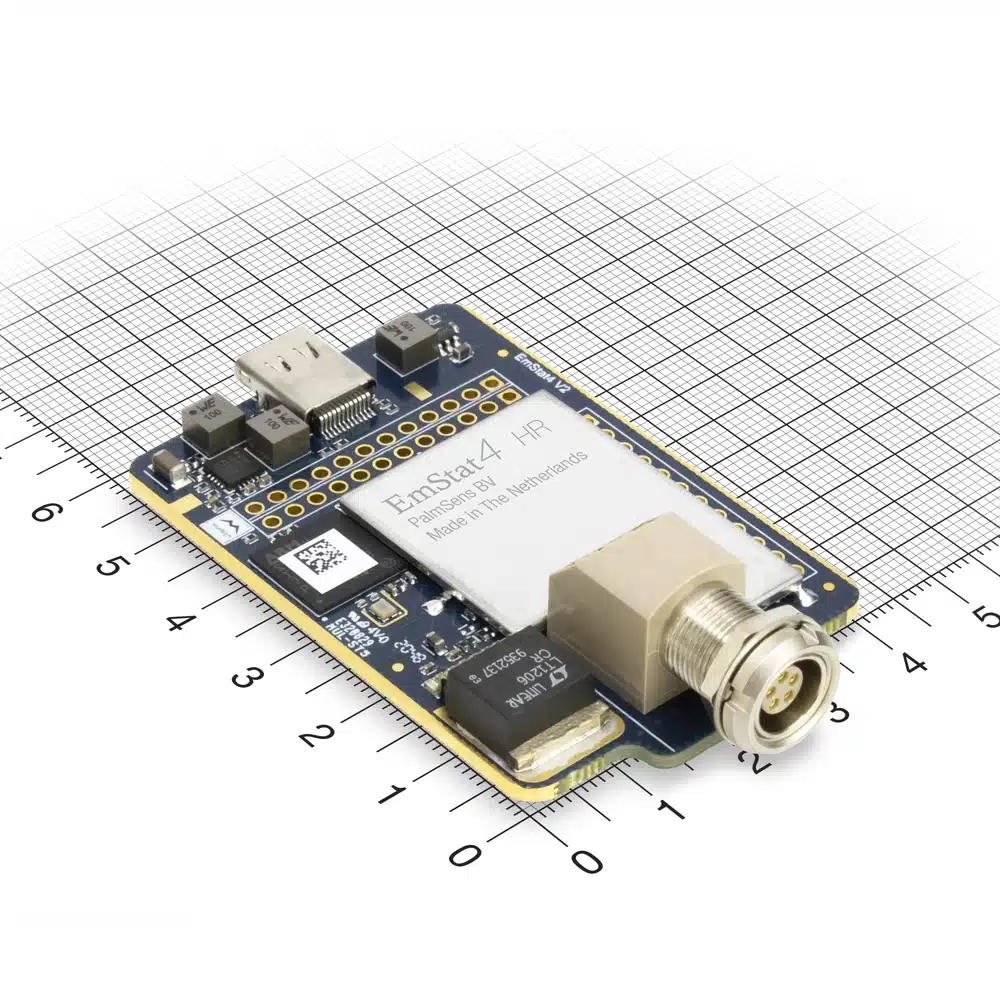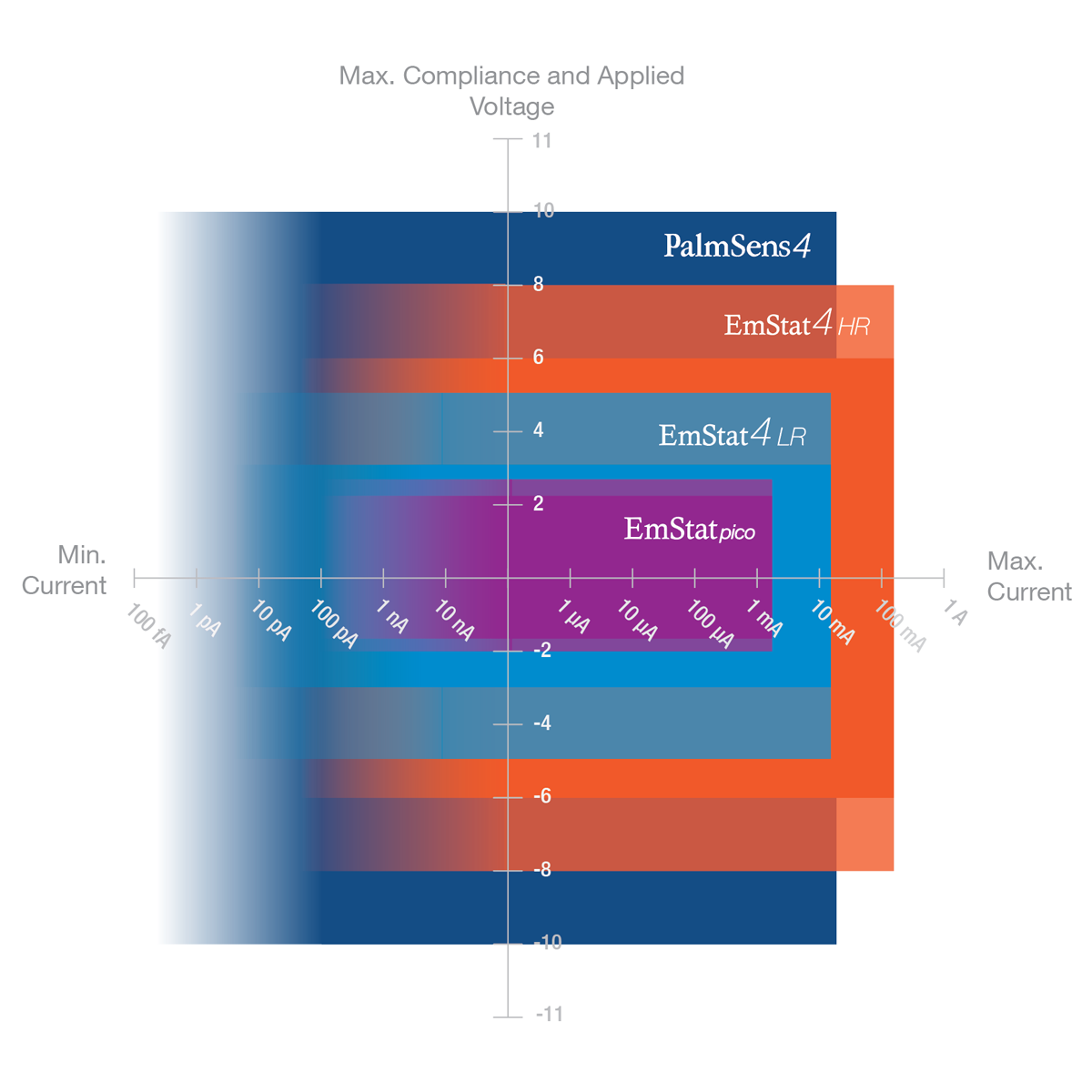EmStat4M Module
Tested & calibrated potentiostat module
- Desktop performance in the palm of your hand
- Enables rapid prototyping
- Easy to reproduce measurements using MethodSCRIPT™
- Many code examples for different languages and platforms
Description
The EmStat4M is a potentiostat/galvanostat module supporting all common electrochemical techniques, including Electrochemical Impedance Spectroscopy (EIS). The EmStat4M can be evaluated with our PSTrace software for Windows. You can write your own applications for the EmStat4M module using our .NET libraries or MethodSCRIPT™ and control it from any platform or operating system.
Versions
The EmStat4M comes in two different versions:
- Low Range (LR): current range from 1 nA to 10 mA (max. 30 mA)
- High Range (HR): current ranges from 100 nA to 100 mA (max. 200 mA)
Both versions can be configured with optional EIS/FRA with a maximum frequency of 200 kHz.
See specifications for more information.
Onboard storage
![]() Every EmStat4M is equipped with an internal storage of 500 MB, equivalent to 15 million data points.
Every EmStat4M is equipped with an internal storage of 500 MB, equivalent to 15 million data points.
This means all your measurements can automatically be saved onboard as a backup.
Start developing with the EmStat4M
The EmStat4M module can be ordered as a bare module or as part of a kit. We offer a Starter Kit and Development Kit as well. The Starter Kit includes a sensor cable, software, and more. The Development Kit comes with the EmStat4M module mounted on a development board. The development board features a Bluetooth module, Li-Ion battery charging, and options for making external connections to an Arduino for example. See the table below for an overview of what is included in both kits.
| Module only | Starter Kit | Development Kit | |
| EmStat4M LR or HR module | |||
| Development Board | – | – | |
| USB-C cable | – | ||
| USB-C splitter cable for extra power (EmStat4M HR only) | – | ||
| Sensor cable (1 meter with 2 mm pins) | – | ||
| 4 or 5 croc clips | – | ||
| Dummy Cell | – | ||
| PSTrace software for Windows (on USB drive) | – | ||
| Quick Start document | – | ||
| Calibration report | – |
Techniques
Voltammetric techniques
Pulsed techniques
Amperometric techniques
Potentiometric techniques
Impedimetric techniques
Other
Specifications
The EmStat4M is available in two versions: LR (Low Range) and HR (High Range).
| Main differences between the EmStat4M Low and High Range | ||
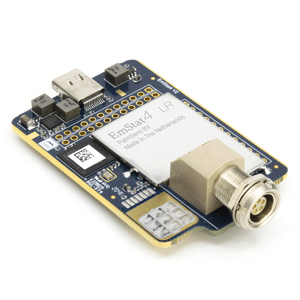 |
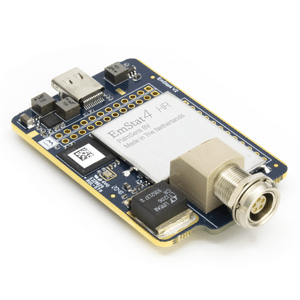 |
|
| EMSTAT4M LR™ | EMSTAT4M HR™ | |
| Potential range | ±3 V | ±6 V |
|---|---|---|
| Max. compliance voltage
The compliance voltage is the maximum voltage that can be applied between the working and counter electrode. Another name could be the maximum cell potential. Continue reading
|
±5 V | ±8 V |
Current ranges
A current range defines the maximum current a potentiostat can measure in a certain range. Continue reading
|
1 nA to 10 mA (8 ranges) | 100 nA to 100 mA (7 ranges) |
| Max. current | ±30 mA | ±200 mA |
| Electrode connections | WE, RE, CE, and ground | WE, RE, CE, Sense, and ground |
| General | ||
|---|---|---|
| LR | HR | |
dc-potential range
The maximum potential difference, that can be applied between WE and RE.
|
±3 V | ±6 V |
compliance voltage
The compliance voltage is the maximum voltage that can be applied between the working and counter electrode. Another name could be the maximum cell potential. Continue reading
|
±5 V | ±8 V |
| maximum current | ±30 mA | ±200 mA |
max. data acquisition rate
Also known as Sampling Rate, it describes how fast the instrument can collect measurement values. Continue reading
|
1 000 000 samples /s | |
| Potentiostat | ||
|---|---|---|
| LR | HR | |
| applied potential resolution | 100 µV | 183 µV |
applied potential accuracy
The applied potential accuracy describes how close to the real values your applied potential is.
|
≤ 0.2% ±1 mV offset |
|
current ranges
A current range defines the maximum current a potentiostat can measure in a certain range. Continue reading
|
1 nA to 10 mA 8 ranges |
100 nA to 100 mA 7 ranges |
measured current resolution
The lowest observable difference between two values that a measurement device can differentiate between. Continue reading
|
0.009% of CR (92 fA on 1 nA range)
CR is the acronym we use for Current Range. A current range defines the maximum current a potentiostat can measure in a certain range. Continue reading
|
|
| measured current accuracy
The current accuracy describes how close to the real values your measured current is. Continue reading
|
≤ 0.2% at Full Scale Range | |
| Galvanostat | ||
|---|---|---|
| LR | HR | |
current ranges
A current range defines the maximum current a potentiostat can measure in a certain range. Continue reading
|
10 nA, 1 uA, 100 uA, 10 mA 4 ranges |
1 uA, 100 uA, 10 mA, 100 mA 4 ranges |
| applied dc-current |
±3 * CR (current range)
CR is the acronym we use for Current Range. A current range defines the maximum current a potentiostat can measure in a certain range. Continue reading
|
|
| applied dc-current resolution |
0.01% of CR |
0.0183% of CR |
| applied dc- current accuracy
The current accuracy describes how close to the real values your measured current is. Continue reading
|
<0.4% (gain) + 0.002 * CR (offset)
CR is the acronym we use for Current Range. A current range defines the maximum current a potentiostat can measure in a certain range. Continue reading
|
|
| measured dc-potential resolution |
96 µV at ±3 V (1 V range) |
193 µV at ±6 V (1 V range) |
| measured dc-potential accuracy | ≤ 0.2% ±1 mV offset | |
| FRA / EIS | ||
|---|---|---|
| LR | HR | |
| frequency range | 10 µHz to 200 kHz | |
| ac-amplitude range |
1 mV to 900 mV rms, or 2.5 V p-p |
|
| measured current accuracy
The current accuracy describes how close to the real values your measured current is. Continue reading
|
≤ 0.2% at Full Scale Range | |
| GEIS | ||
|---|---|---|
| LR | HR | |
| frequency range | 10 µHz to 100 kHz | |
| ac-amplitude range |
0.9 * CR (Arms)
CR is the acronym we use for Current Range. A current range defines the maximum current a potentiostat can measure in a certain range. Continue reading
|
|
| Electrometer | ||
|---|---|---|
| LR | HR | |
electrometer amplifier input
The amplifier input resistance of the amplifier in the electrometer determines the load that the amplifier places on the source of the signal being fed into it. Ideally the resistance is infinite, and the load to be zero to not to influence your measurement.
|
> 1 TΩ // 10 pF | |
bandwidth
Bandwidth defines the range of frequencies a system can accurately measure or respond to. Continue reading
|
10 kHz default or 500 kHz for EIS and fast CA/CP |
|
| Other | ||
|---|---|---|
| LR | HR | |
| electrode connections |
WE, RE, CE, |
WE, RE, CE, S |
| dimensions | 62 mm X 40 mm X 7 mm | |
| weight | ± 130 g | |
| power + communication | USB-C port | |
| internal storage space | 500 MB, equivalent to > 15M datapoints | |
| EmStat4M LR EIS Accuracy Contour Plot |
|---|
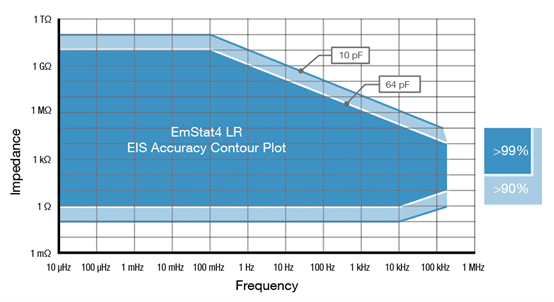 |
| EmStat4M HR EIS Accuracy Contour Plot |
|---|
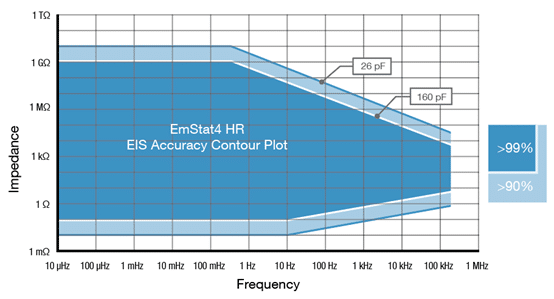 |
Software
PSTrace
PSTrace is designed to be productive immediately after installation, without going through a long learning period. It has three modes; the Scientific mode which allows you to run all the techniques our instruments have to offer, and two dedicated modes for Corrosion analysis and the Analytical Mode. PSTrace is suitable for all levels of user experience.
Features include:
- Direct validation of method parameters
- Automated peak search
- Equivalent Circuit Fitting
- Scripting for running an automated sequence of measurements
- Open data in Origin and Excel with one click of a button
- Load data from the instrument’s internal storage
- and many more…
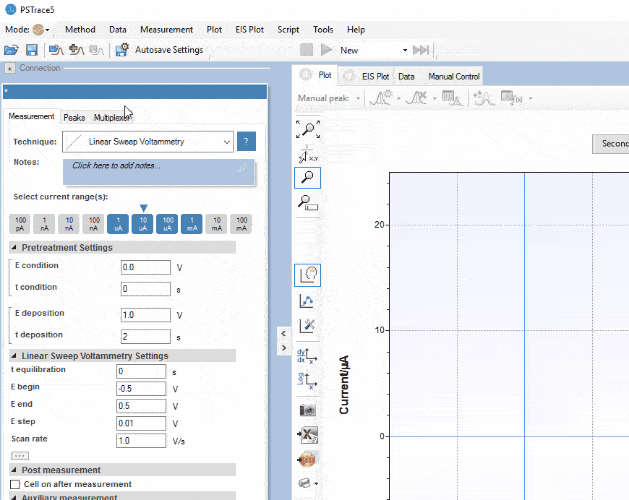
Software Development Kits
PalmSens provides several Software Development Kits (SDKs) to help developers create custom software to control their potentiostat. Each SDK comes with documentation and examples that shows how to use the libraries.
SDKs are available for:
- .NET (WinForms, WPF and Xamarin for Android)
- Python
- LabVIEW
- Matlab
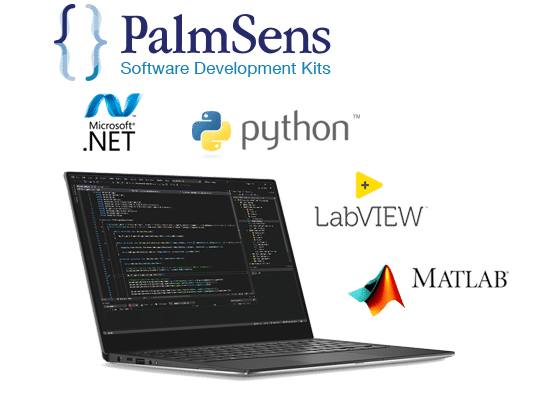
MethodSCRIPT™ Communications Protocol
The Nexus works with MethodSCRIPT™, giving you full control over your potentiostat. The simple script language is parsed on-board, which means no DLLs or other type of code libraries are required. MethodSCRIPT™ allows for running all supported electrochemical techniques, making it easy to combine different measurements and other tasks.
MethodSCRIPT can be generated, edited, and executed in PSTrace.
MethodSCRIPT features includes:
- (Nested) loops and conditional logic support
- User code during a measurement iteration
- Exact timing control
- Simple math operations on variables (add, sub, mul, div)
- Data smoothing and peak detection
- Digital I/O, for example for waiting for an external trigger
- Logging results to internal storage or external SD card
- Reading auxiliary values like pH or temperature
- and many more…

Downloads
Other (2)
| Name | Last updated | |
|---|---|---|
| EmStat4M 3D STEP File Contains two STEP files for both EmStat4M LR and HR. Note that the optional USB connector at the bottom is normally not populated. The HR does not include the heat sinks on the heat pads. See also the EmStat4 HR Datasheet. | 19-08-24 | |
| EmStat4M Altium symbol and footprint The ZIP file contains an Altium library with EmStat4M footprint and symbol | 19-10-21 |
Software (8)
| Name | Last updated | |
|---|---|---|
| PSTrace PC software for all single channel instruments PSTrace software is shipped as standard with all single channel and multiplexed instruments. The software provides support for all techniques and device functionalities. | 08-07-24 | |
|
MethodSCRIPT code examples
MethodSCRIPT code examples include:
- MethodSCRIPTExample_C - MethodSCRIPTExample_C_Linux - MethodSCRIPTExample_C# - MethodSCRIPTExample_Arduino - MethodSCRIPTExample_Python - MethodSCRIPTExample_iOS - MethodSCRIPTExample_Android Every code example comes with a "Getting Started" document. |
07-07-24 | |
| EmStat4 Firmware v1.3.4 See app note "EmStat Pico firmware updating" for more information about updating built-in and bare EmStat4M modules. | 25-03-24 | |
| EmStat4 Firmware v1.2.3 See app note "EmStat Pico firmware updating" for more information about updating built-in and bare EmStat4M modules. | 08-02-23 | |
| PalmSens SDK for Python PalmSens Python SDK 5.12 with support for instruments from PalmSens BV on Windows systems. | 07-11-22 | |
| Getting started with PalmSens SDK for WPF This manual explains how to use the SDK with the included libraries and examples. | 07-06-21 | |
| Getting started with PalmSens SDK for WinForms This manual explains how to use the SDK with the included libraries and examples. | 07-06-21 | |
| Getting started with PalmSens SDK for Android This manual explains how to use the SDK with the included libraries and examples. | 07-06-21 |
Documentation (10)
| Name | Last updated | |
|---|---|---|
| EmStat4M Brochure EmStat4M Brochure including main specifications and practical limitations. | 25-04-24 | |
| MethodSCRIPT v1.5 The MethodSCRIPT scripting language is designed to improve the flexibility of the PalmSens potentiostat and galvanostat devices for OEM users. It allows users to start measurements with arguments that are similar to the arguments in PSTrace. PalmSens provides libraries and examples for handling low level communication and generating scripts for MethodSCRIPT devices such as the EmStat Pico and EmStat4. | 25-03-24 | |
| EmStat4M Communication Protocol V1.3 Describes how to communicate with the EmStat4M directly and how to send MethodSCRIPTS. | 25-03-24 | |
| EmStat Pico and EmStat4 bootloader commands This document explains how to enter the bootloader of the EmStat Pico or the EmStat4M and update the firmware. | 05-10-23 | |
| EmStat4M Communication Protocol V1.2 Describes how to communicate with the EmStat4M directly and how to send MethodSCRIPTS. | 01-02-23 | |
| MethodSCRIPT v1.4 The MethodSCRIPT scripting language is designed to improve the flexibility of the PalmSens potentiostat and galvanostat devices for OEM users. It allows users to start measurements with arguments that are similar to the arguments in PSTrace. PalmSens provides libraries and examples for handling low level communication and generating scripts for MethodSCRIPT devices such as the EmStat Pico and EmStat4. | 01-02-23 | |
| EmStat4M Connection Card This connection card provides an overview of the connector pin-outs. | 14-03-22 | |
| MethodSCRIPT v1.3 The MethodSCRIPT scripting language is designed to improve the flexibility of the PalmSens potentiostat and galvanostat devices for OEM users. It allows users to start measurements with arguments that are similar to the arguments in PSTrace. PalmSens provides libraries and examples for handling low level communication and generating scripts for MethodSCRIPT devices such as the EmStat Pico and EmStat4. | 19-01-22 | |
| EmStat4M Communication Protocol V1.0 Describes how to communicate with the EmStat4M directly and how to send MethodSCRIPTS. | 14-10-21 | |
| MethodSCRIPT v1.2 MethodSCRIPT v1.2 protocol description | 28-04-20 |
Datasheet (1)
| Name | Last updated | |
|---|---|---|
| EmStat4M Datasheet Document with more detailed specifications including module pin-out. | 30-11-23 |
Application Note (1)
| Name | Last updated | |
|---|---|---|
| Migrating to the EmStat4M LR or HR This Application note shows the differences between our older and latest EmStat modules which are relevant when switching your software and electronics design to work with the EmStat4 LR or HR. | 06-10-22 |




















